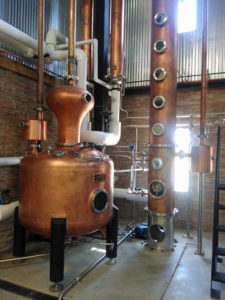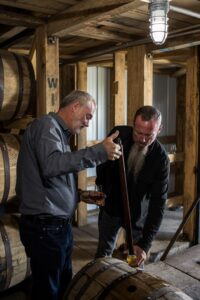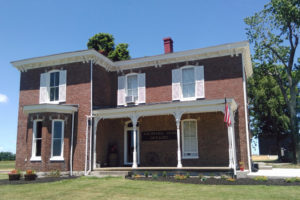Wilderness Trail’s Coming Of Age
The Bluegrass Distillery Has Grown From Craft To Bourbon Institution
By Richard Thomas

(Credit: Richard Thomas)
The first time I called on Wilderness Trail was early summer 2016. Located in picturesque Danville, a college town on the southern boundary of the Bluegrass that is an example of “ye can’t get thar from here!” (whatever direction you come from, it seems you must go somewhere else first to get to Danville), it required special effort on my part to get there. Yet the timing was excellent: founders Shane Baker and Pat Heist had just made the move from a micro-distillery in a storage unit in Danville to an old cattle farm on the outskirts of town, complete with 19th Century farmhouse. That move included the transition from a pot still to a Vendome 18-inch column still, which had been in operation for just a year.
Wilderness Trail differed from so many craft distilleries around America in its founders. Shane Baker and Pat Heist were not newcomers to distilling, having co-founded Ferm Solutions in 2006. The pair had met playing for a rock band in Pikeville, Kentucky. Baker was an engineer who had moved over to working for venture capitalists, consulting on how to revive or break up acquired companies. Heist was a micro-biologist who had been teaching at medical schools. Together they got together and began consulting on commercial distilling, although that meant working in the American ethanol fuel industry for the most part. Your car had been sipping on the handiwork of Heist and Baker long before anything they made had even the slightest chance of passing your lips. The pair didn’t start Wilderness Trail and distill their first barrel of whiskey until 2013.

(Credit: Campari)
So I met the pair three years into their new booze-making enterprise, and it was still very much early days for the company. They had, in fact, only recently changed the company name from Wilderness Trace, after a certain company with a distillery in Frankfort objected to the use of the word “Trace.” The property had the two original farm buildings, a barn and the red brick farmhouse, plus the distillery building, bottling plant and a small 2,200-barrel rickhouse. The latter was so small as to be unique in Kentucky; Rob Samuels is said to have labeled it “cute.”
I was aware of how Wilderness Trail had grown in the eight years since in a statistical sense. I knew about how they preferred to wait four or five years for their own production to be ready for release as bottled in bond whiskeys, and how those initial releases had since come out. In 2017, they bought the property across the road; later that same year, the company announced an almost $10 million expansion plan.
Knowing all that is very different from seeing it, however. Approximately a dozen medium-sized rickhouses have been erected; a visitor center built; and a 36-inch column still added, effectively tripling output over what they had in 2016. That meant Wilderness Trail was filling approximately 70,000 barrels per year before their first expression had been released. The crown on all that growth came on Halloween Day 2022, when Campari announced they were buying a 70% stake in Wilderness Trail.

(Credit: Wilderness Trail)
It’s a truly meteoric rise. As described, Wilderness Trail rose from operating a very crafty scale to having a truly medium-sized distillery in just a few years, and then to what I’d say pushes the boundaries separating medium-sized from large distilling just a few years later. Kentucky has seen some newcomers in the middle and large scale sectors in recent years, but Bardstown Bourbon Company, Rabbit Hole and New Riff all started out as mid-sized producers. Bardstown Bourbon Company had quadruple expansion baked into its DNA/building plans from the beginning. What Wilderness Trail did was very different indeed, and it begs the question of how Baker and Heist accomplished it all.
First, it has to be said that Wilderness Trail completed its first expansion at a very good time in the middle 2010s. Much like New Riff Distilling in Northern Kentucky, they had ample production capacity at a time when numerous sourced brands were either coming into being or else looking for someone to contract produce their whiskey at a time when all the Kentucky Majors (the state’s big distillers) were all exiting the business of contract distilling and/or quietly trading in aged stock whiskey.

(Credit: Richard Thomas)
That contract production became the engine for the company’s rapid growth. Wilderness Trail has over a quarter million barrels of whiskey stored in their rickhouses, but the overwhelming majority of those barrels belong to their contract customers. Equally important in that picture were Shane and Pat themselves: hiring Wilderness Trail as your contract producer also meant employing the expertise of two men who were fast becoming known as “the Science Guys of Bourbon.”
The other side is the buzz that surrounded Wilderness Trail and what they were doing. By committing to bonded whiskeys, and thereby deciding to sit on it for four or five years before releasing it, Baker and Heist earned their brand as much credit for authenticity a newcomer could possibly get, and authenticity is valuable currency with bourbon nerds.
Yet they also veered off in their own distinct direction from the rest of the Kentucky bourbon industry. In a state known for sour mash whiskey-making, Wilderness Trail is a sweet mash shop. Sour mash refers to the practice codified by Dr. James Crow in the early 19th Century of using backset (leftovers from the previous batch) in starting a new mash for whiskey. In an era when germ theory was either unknown (and later not yet widely accepted), sour mash was a preventative step against contamination and helped achieve consistency. Today, sour mash is more traditional, but not necessary more efficient. Also, as the terms sour and sweet mash imply, sour mashes are more acidic, which has its influence on the flavors coming out of that mash.
 Another feature that set them apart from everyone else in Kentucky is their low corn style of bourbon-making. Both the wheat and rye bourbons use 64% corn, with 24% wheat or rye respectively. That is about 10% lower than the norm for corn, with the flavoring grain being a little higher than normal and the difference made up by more barley. They also favor Cooper’s Select barrels from Independent Stave Company, which utilize staves that have been air seasoned for 1 1/2 to 2 years.
Another feature that set them apart from everyone else in Kentucky is their low corn style of bourbon-making. Both the wheat and rye bourbons use 64% corn, with 24% wheat or rye respectively. That is about 10% lower than the norm for corn, with the flavoring grain being a little higher than normal and the difference made up by more barley. They also favor Cooper’s Select barrels from Independent Stave Company, which utilize staves that have been air seasoned for 1 1/2 to 2 years.
This is not to say everything at Wilderness Trail is running against the grain of Kentucky norms. Their rye fits very much in the Kentucky rye style; they use #4 alligator char on those very seasoned barrels; and their entry proof of 134 is typical. Still, the distillery does its own thing in just enough ways to set itself apart from the neighbors, and that is something that tends to excite nerds as well. Moreover, it suits their somewhat isolated location in Danville, which is quite off the beaten track of the Kentucky Bourbon Trail.
The last element is Baker and Heist themselves. They brought a potent combination of business, chemical and engineering expertise to their start-up; it’s hard to imagine anyone except John Teeling who knew more about how to start a whiskey-making company than these two before embarking on that very project. But beyond that is Pat Heist, who is a natural evangelist for his process and product. In an era when Master Distillers have taken on some of the glamour of a rock star and are counted upon to be ambassadors, Heist’s enthusiasm is infectious and anyone who hears him speak about how he makes Wilderness Trail should want to have some.



